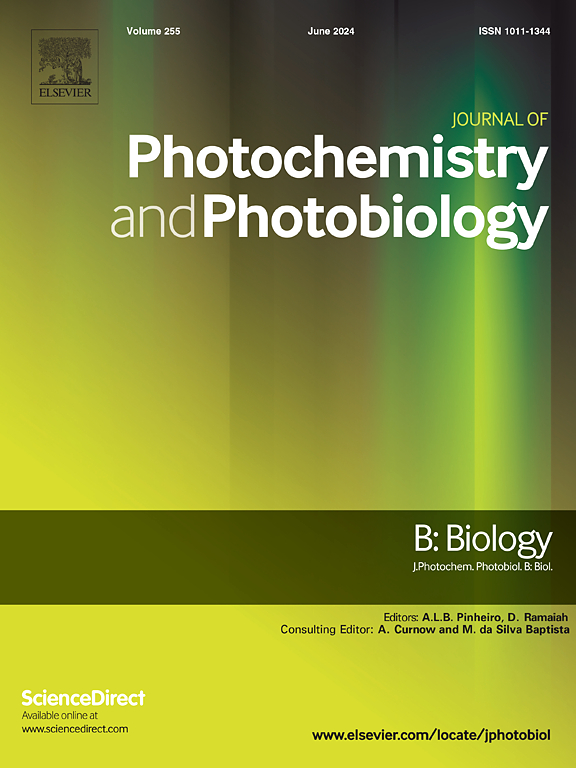Near-IR quantum dot (BagQD) as fluorescent sensor for live-cell imaging and in-vivo antibacterial photocatalytic therapy (APT)
IF 3.7
2区 生物学
Q2 BIOCHEMISTRY & MOLECULAR BIOLOGY
Journal of photochemistry and photobiology. B, Biology
Pub Date : 2025-09-24
DOI:10.1016/j.jphotobiol.2025.113271
引用次数: 0
Abstract
The development of multitasking agents that can sense, as well as damage multidrug-resistant (MDR) bacteria with no growth, is the need of the hour to overcome the increased mortality associated with antibacterial resistance. Toward this end, to overcome the limitation of organic dyes as fluorescence probes, and other developed quantum dots (QD), we present new of its kind near infrared type-I (NIR-I) CdSe/ZnSe/FeTiO3-based perovskite quantum dot, BagQD, for fluorescence-guided selective bacterial imaging-sensing and permanent disinfection. BagQD possesses unique photodynamic and photophysical properties of the near-infrared NIR-I biological window. The excellent electronic transitions of BagQD resulted in efficient quantitative fluorescent sensing-imaging of gram-positive (G+ve) as well as gram-negative (G-ve) bacterial pathogens, and complete in-situ and in-vivo disinfection/elimination of pathogenic bacteria without regrowth via damaging bacterial cell wall and cellular DNA, by ROS generation during photocatalysis. The material cytotoxicity study showed no harm to the human cell line. Moreover, the therapeutic application of BagQD on in-vivo mice skin wound infection, revealed the generation of hair follicles and epithelization within 6–8 days. Thus, BagQD serves as a new alternative to antibiotics and a smart nanomedicine that can uphold the hope in revolutionizing diagnostics and clinical avenues.

近红外量子点(BagQD)作为荧光传感器用于活细胞成像和体内抗菌光催化治疗(APT)
为了克服与抗菌药物耐药性相关的死亡率上升,迫切需要开发能够感知并破坏未生长的多药耐药(MDR)细菌的多任务制剂。为此,为了克服有机染料作为荧光探针和其他量子点(QD)的局限性,我们提出了一种新的近红外i型(NIR-I) CdSe/ZnSe/ fetio3基钙钛矿量子点BagQD,用于荧光引导的选择性细菌成像传感和永久消毒。BagQD具有独特的近红外NIR-I生物窗口光动力学和光物理特性。BagQD优异的电子跃迁特性使其能够对革兰氏阳性(G+ve)和革兰氏阴性(G-ve)病原菌进行高效的定量荧光传感成像,并在光催化过程中产生ROS,通过破坏细菌细胞壁和细胞DNA,完成病原菌的原位和体内消毒/消除,而不再生。细胞毒性实验表明,该物质对人体细胞系无危害。此外,BagQD对小鼠皮肤伤口感染的治疗作用显示,在6-8天内毛囊和上皮的产生。因此,BagQD作为抗生素的新替代品和智能纳米药物,可以为革命性的诊断和临床途径带来希望。
本文章由计算机程序翻译,如有差异,请以英文原文为准。
求助全文
约1分钟内获得全文
求助全文
来源期刊
CiteScore
12.10
自引率
1.90%
发文量
161
审稿时长
37 days
期刊介绍:
The Journal of Photochemistry and Photobiology B: Biology provides a forum for the publication of papers relating to the various aspects of photobiology, as well as a means for communication in this multidisciplinary field.
The scope includes:
- Bioluminescence
- Chronobiology
- DNA repair
- Environmental photobiology
- Nanotechnology in photobiology
- Photocarcinogenesis
- Photochemistry of biomolecules
- Photodynamic therapy
- Photomedicine
- Photomorphogenesis
- Photomovement
- Photoreception
- Photosensitization
- Photosynthesis
- Phototechnology
- Spectroscopy of biological systems
- UV and visible radiation effects and vision.

 求助内容:
求助内容: 应助结果提醒方式:
应助结果提醒方式:


